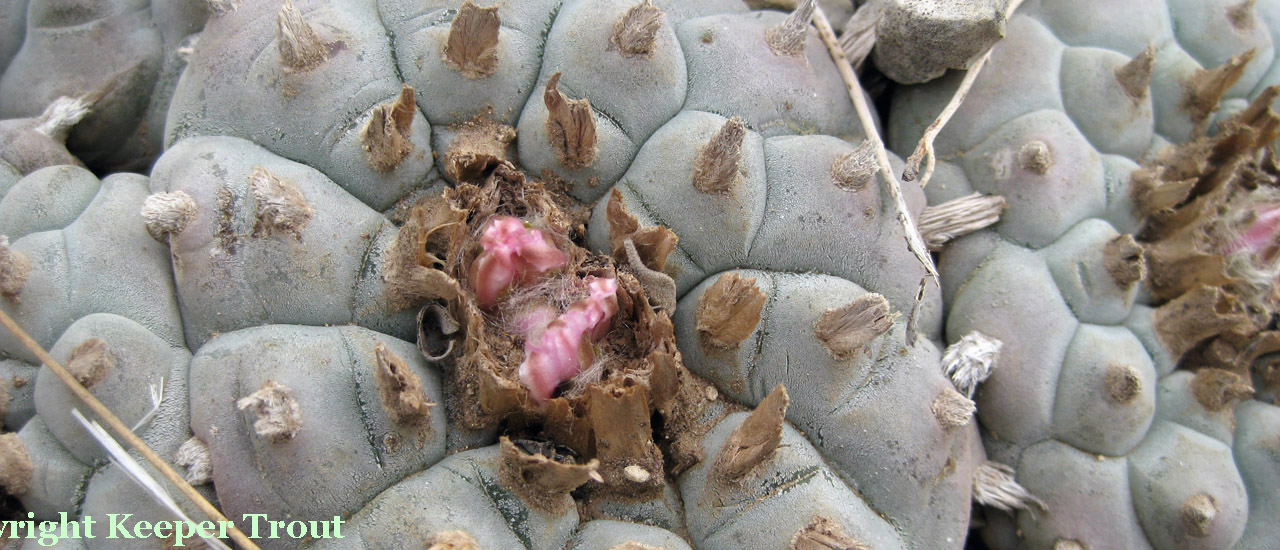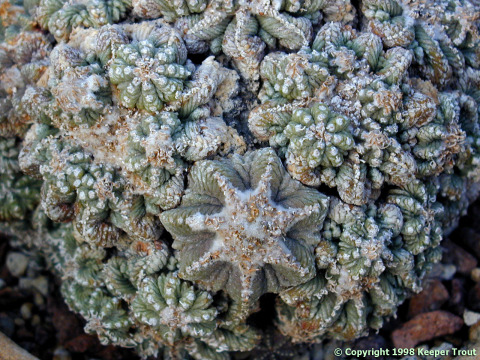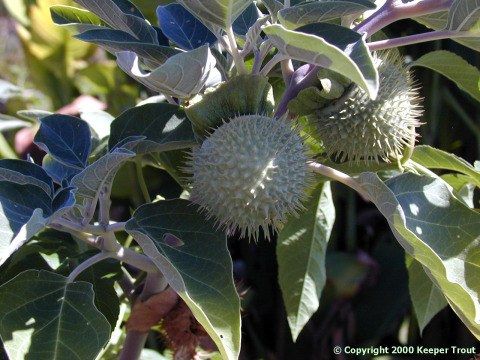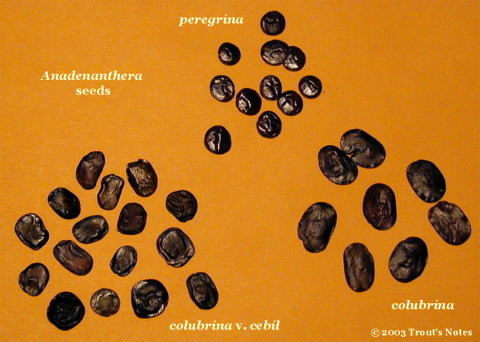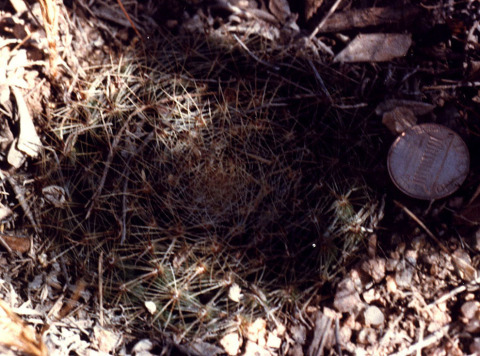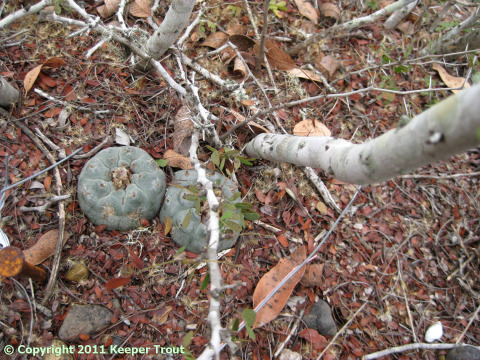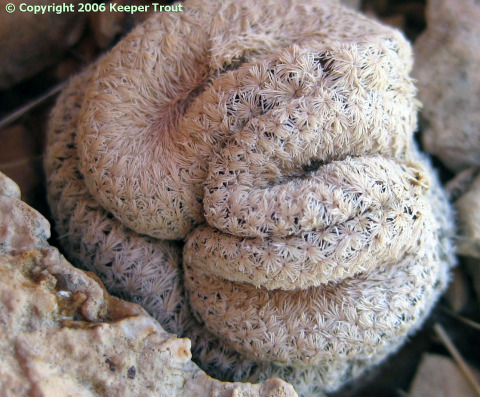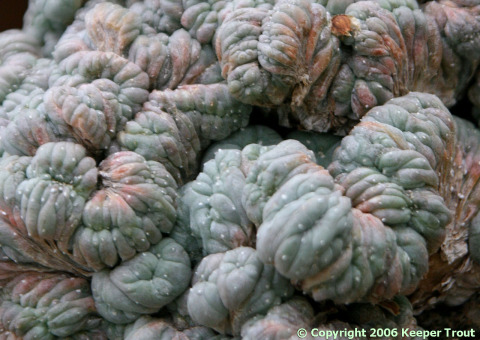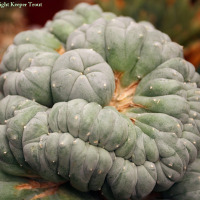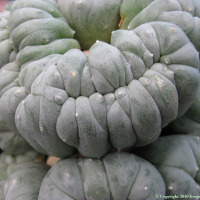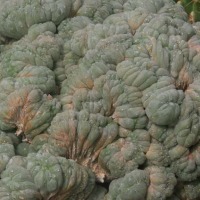Occurrences of Mescaline Endnotes
Note 1: Also rendered as Boedecker.
Note 2 (Aztekium): The polycephalic (multiheaded) specimens that are depicted of these typically unbranched plants arose in greenhouse situations. This is believed to be the result of routine pesticide application.
Note 2 (Gymnocalycium): Colorless birefringent crystals, n 1.544, mp 160-162° were claimed to show the “reactions of mescaline”.
Note 3: In my only query on the matter (a pay-phone call made to the DEA in early 1996), I was informed that the US Drug Enforcement Agency knows nothing about the existence of another peyote species. They were very reluctant to even discuss the matter with me. They did say that since state law prohibits possession of the drug, they would definitely arrest a person for growing peyote, in any quantity, even if for horticultural purposes. (They also mentioned that they recently did.) They also said that they would definitely arrest anyone who had a plant that they felt even “looked like peyote”. When asked if the known lack of mescaline would make it legal to grow, they remarked it would “make a good legal defense” but pointed out it might take a week or more to get the test results back from the lab, during which time one might have to stay jailed. They agreed with my assertion that their idea of proving the plants in question did not contain mescaline would require their destruction.
Even worse, their idea of testing was said to consist of determining how many “dosage units” are in the cactus material on hand, not simply whether it contains mescaline or not. This would require the use of all plants present, not just a small sample. (Mescaline’s presence or absence could be determined with even a small portion sampled from a living cacti, without requiring its death.)
The logic on this bring to mind the old test for pearls of dropping them into a glass of red wine, (if it ruins them they were real, if it doesn’t they are fake), or the tests for ‘proving’ someone a witch by dunking them repeatedly under water or crushing them with rocks under a board (if they live they are a witch, if they die, they were not).
The Inquisition still lives but the modern ‘witch hunt’ is now for drugs.
Ott’s notion concerning the evolution of the Theocratic Inquisition into a Pharmacratic Inquisition is very accurate.
The actions of the 1997 Congress could be construed as making even the hairs from a Lophophora diffusa illegal but so far as I can tell that issue has never gone to court.
Note 4: This was L. diffusa being analyzed as L. echinata. This is an incorrect designation for L. diffusa not uncommonly, but unfortunately, encountered in European collections.
Croizat described L. echinata as being from Texas and went on to describe L. diffusa as L. echinata var. diffusa. This, Backeberg’s heavy reliance on Croizat’s assessment of Lophophora and an apparent overall dislike of trinomials has sadly contributed to the predominance of L. diffusa as the plants labeled L. echinata in Europe.
L. echinata (L. williamsii var. echinata sensu Weniger) is also commonly used in the US for the greyish, larger & higher alkaloid material found in southern Trans-Pecos Texas and southward into Coahuila.
It is probably, at least partly, synonymous with the Coahuilan material NOW being called L. decipiens by European cactophiles. Some of what is regarded as L. decipiens is obviously L. fricii.
Note 5: Possible error on my part. Štarha 1997 lists this as O-Methylanhalinine which I assumed was a typo (as a compound with this name cannot physically exist).
Note 6: This is not the major alkaloid when compared to the pellotine present.
Note 7: There appears to be some discrepancy as this is not a minor alkaloid with regards to the mescaline reported to be present.
Note 8: Also described as Lophophora williamsii var. koehresii (Ríha) Grym. See Grym 1997.
Note 9: In Štarha & Kuchyňa 1996 this appears as a typo (anhalamine is listed twice). I based this assignment on a comparison of the gc value with those in Štarha’s other papers.
Note 10: I am apparently lacking the right diacritics. “íi” needs cedillas on both characters.
Note 11: And also being sold as ground Baby Hawaiian Woodrose during the same time frame. It is impossible to confuse the effects produced by these very different drug plants.
Note 12: The mistake of jumping from the assumption of “probably” directly into ‘fact’ was made in the same paper where he does an amazing job of disentangling the confusion which at that time surrounded cohoba and tobacco. Safford correctly associated of cohoba, parica and niopa (and other local names) with Anadenanthera peregrina (then known as Piptadenia peregrina) and described the use of its seeds as snuffs and, in some cases, as an enema (citing Spix & Martius 1831).
See also Safford 1916b or refer to Some Simple Tryptamines PDF or see the Anadenanthera section in the online Ayahuasca book at the Erowid website for more details and a discussion of various snuff sources.
An interesting observation was made by Safford concerning Siméon 1885. Rémi Siméon is said to have [correctly] stated that Teonanacatl was a small mushroom, that tastes bad, causes hallucinations and intoxication and was used for fevers. Safford somehow concluded: “Three centuries of investigation have failed to reveal an endemic fungus used as an intoxicant in Mexico, nor is such a fungus mentioned in either works on mycology or pharmacology, yet the belief prevails even now there is a narcotic fungus…” Safford then goes on to dismiss this persistent belief as an error, concluding that the sacred fungus was actually a dried cactus. [One must wonder just what three centuries of investigations Safford refers to since both early Spanish and Mexican investigations would have only had its destruction (and obliteration from common knowledge) in mind and the Spanish chroniclers certainly mentioned AND depicted mushrooms being used in a supernatural context.]
What is perhaps more puzzling is that if he had consulted any of a number of medical or mycological journals of his day he would have found ample references to the always non-fatal accidental poisonings characterized by “gay hilarity” and colored hallucinations. A number of references, in Africa, Europe and the US, existed, even in the 19th century, as to the effects of the accidental, always non-lethal, “poisonings” by Paneolus spp. and other Psilocybin containing mushrooms. [See our forthcoming work on Psilocybin containing plants for references and more detail.]
To add a strange twist to what Safford’s claims, on page 264 in John Borg 1937, appears these curious words that seem to diverge in the opposite direction:
” This is the famous mescal or peyotle of the ancient Mexicans, who used to cut off the top of the plant and eat it at their festivals, an evil practice which is now prohibited by law [Ed.: this refers to the law in Mexico]. The plant has powerful exhilarating, and afterwards narcotic, properties, similar to those of Indian Hemp or Hashish, in this case due to three alkaloids, viz.: mescaline, lophophorine and anhalonine. The term mescal means a mushroom, and the dried tops of the plant strung into chaplets or garlands, used to be sold as mescal in the Mexican markets, and as botanical travellers were in search of a fungus and not of a Cactus, it was a long time before it was ascertained that the so-called mescal buttons were the dried tops of this Cactus.”
In an intriguing early mention of peyote; Sahagun describes it as being white and produced in the North. This is usually taken to mean a misidentification of peyote with the sacred mushroom. [Which, actually, also are not white, most early writers referred to them as tawny. Sahagun actually described the mushrooms as being black in the 16th century. I wonder, however, if perhaps, the description of the peyote as white is more in reference to the color of the Peyote, itself. When it manifests itself, it is frequently accompanied by the presence of pure brilliant white light Despite having no proof I have to wonder if this might have been what the Aztec informants of the Spaniards were referring to. [Alternately, it could have just been in reference to the prominent white tufts on the dry cactus as opposed to the often dark dried mushrooms. Most commercially produced Psilocybin mushrooms today are not dark.) I similarly once found myself describing the difference between mushrooms and peyote; as the mushrooms being small, dark, warm and colorful and the peyote as being very large and bright white (and also colorful). Another more easily noticeable difference is that the colors and patterns of the phosphenes perceived with peyote have a background matrix of a pure rosy glow. (In contrast to the background matrix of deep purple I observe with mushrooms.)
Note 13: Martin et al 1971 also made the odd claims that early explorers thought dried buttons were fungi and that Mescal is “the word for fungus”. I can not substantiate either point as the Spanish chroniclers clearly mentioned peyote and the sacred mushrooms as completely distinct entities (peyote was referred to as a root; the Psilocybe mushroom as a fungus) and exhibited absolutely no confusion about the two. The confusion in print appears to have begun with William Safford somewhere around the beginning of the 20th century. Martin may have drawn this from Borg but the source for his claim was not made clear.
Martin also commented that mescaline “is said to increase color perception, if it does not make one too disgustingly sick to be aware of anything!” […] “the Indians do not just sit around chewing the dried buttons in a mass orgy. They go through a series of fasts and taboos that would discourage even the most ardent seeker of sensations.”
One would suppose, if all of that was really believed to be true, that Martin would have much fewer concerns about peyote use and abuse?
Note 14: Rätsch 1998 presents white mule as meaning fat- or thick- headed but does not include his reasoning which really should be questioned.
Note 15: Some years ago, a ranger at Enchanted Rock (a batholith) insisted that Mammillaria heyderii did not and could not exist at the park because neither they nor the expert who was completing a native plant survey were aware of them (the absence of this species from their list was the sole reason this subject was mentioned to them).
In more recent years it was noticed and added to their plant list, although their botanist assigned the wrong ID and has inexplicably identified it as the Mexican species Mammillaria gummifera. Which would prove to be a very significant extension of its known range if true. An intriguing claim (in that same report) of a range extension for M. prolifera is at the very least tempered by their botanist’s identification of Opuntia imbricata as O. tunicata.
Note 16: Some may not think of this as a substantial source of loss unless they visited south Texas several decades ago and saw the huge stinking piles of Mexican plants which were stripped from the desert by the truckload simply because they were cacti. Large areas of the Mexican deserts were nearly denuded of cacti except for Opuntia.
Note 17: This is a commonly held, but erroneous, point of confusion. In Texas, this is correctly known as Acacia rigidula.
True Acacia amentacea is restricted to southwestern Mexico. (See Correll & Johnson 1970 for more details.)
Acacia rigidula is abundant in the Texas’ peyotelands, also Chihuahua, Coahuila, Jalisco, Nuevo León, San Luis Potosí & Tamaulipas, in Mexico. It also occurs more rarely in trans-Pecos Texas westward to Brewster County. That combined area also contains the vast majority of peyote’s natural range. Interestingly, Acacia rigidula was purported to contain mescaline and a number of other cactus alkaloids in its aerial parts although the validity of those findings has been challenged. (See Clement et al. 1998).
With results very much in a line with reports of earlier workers such as Adams and Camp, Pawar reported a resounding failure replicate any of their novel claims.
Sasha Shulgin had also commented to me that despite their assertion of obtaining their reference standards from commercial sources, a goodly number of them are not available through any commercial source and at least one of their novel compounds has never even had a synthesis published. Efforts of a correspondent to learn more from her coauthor Forbes was told that there was no awareness of any controvery and all molecules were identified using a published compendium of spectral data. (I’d suggest that comment might be disingenuous or at least I would invite readers to read what is actually said in the report of Clement concerning how they made their identifications.) Very clearly any and all of the novel compounds reported in Clement’s two papers presently are in need of proof that they actually exist in those Acacia species.
Note 18: They are easily removed and rooted once their roots start forming. Before this time there will be a fairly high mortality rate if removed while small. If one is patient enough to let them get to over an inch in diameter the survival rates will be quite high even on unrooted cuttings.
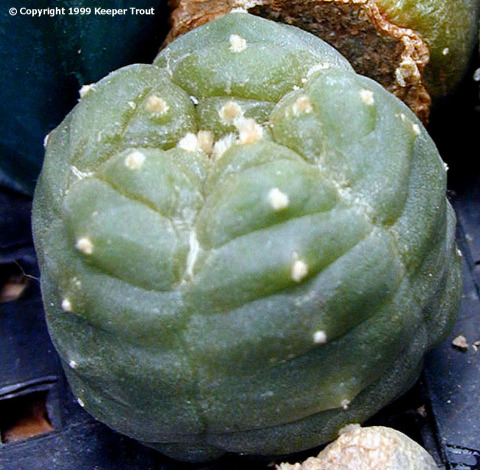
Lophophora williamsii cut for grafting in a commercial greenhouse.
This cutting would root just fine.
Note 19: Etiolation in peyote causes formation of a rounded spike of the inner most areoles. They can grow to over an inch in height in a matter of weeks.
The color of the projecting, mostly hairless, tubercles starts out as bright pale green (the body still being blue-green), then turning yellow along the furrows, going to yellow with white furrows, and eventually becoming nearly pure white before the rest of the plant (by now pale green) dries up and dies. This is an important survival mechanism for these plants.
Since they are low growing, in winter or in bad weather, they sometimes become partially or entirely covered by blown or washed soil. This rapid elongation enables them to get through to the light and resume growth if buried. If one examines the barky rings (formerly the outermost and oldest green tissues) that surround the upper root (on an old plant) they will often find occasional deep indentations indicating the years that the plant had to partially or totally etiolate to unbury itself.
It would be interesting to see if there was a usable correlation between known weather history of the area of occurrence and the morphology of the barky rings which might provide better estimates on actual age of older plants.
My belief is that they can get extremely old.
Many species of cacti can live for 200 years or more and there is no reason to believe that peyote is any different.
Note 20: Cristate growth, while infrequent, does occur in many plants.
What has happened is that, either, supposedly, from mechanical injury, or more likely from some other more poorly understood mechanisms, the point of growth at the center top of the plant (the apical meristem) is no longer a point of symmetry, from which all new growth occurs, but rather it has a line (plane) of symmetry from which all growth occurs (fasciation). Cristate plants express it as a wavy line that grows increasingly convoluted rather than staying planar.
While the predomininant belief is that crests arise from injury, it is a demonstrable fact that, so far, NO ONE has ever been able to *deliberately* create a crest by injuring a cactus.
Many attempts have been made by a decent number of people using everything from knives to acids; all have been resounding failures. There is however a claim in need of a controlled evaluation that damages resulting from high heat induced the appearance of new crest formations.
On the other hand, monstrose and cristated individuals arise regularly and naturally within any large enough planting of seeds of a single species. They can apparently arise in any cactus species so should be anticipated to exist for all of the known Lophophora species.
There are areas in the US and Mexico (and thus probably also elsewhere) which are known to hold an unusually high number of cristate plants involving multiple species, genera and/or families of plants. It is actually fairly common for cristation to occur in a given area and to also involve multiple plant species. It is not uncommon to find several specimens with varying degrees of cristate expression concentrated in a small area within a larger population of normal plants.
There are also major cactus collections that have deliberately acquired a large number of cristate specimens. In those collections there is a far higher than normal appearance of cristation and monstrose growth in *additional species* in their garden suggesting that some type of a pathogenic vector may be involved. Phytoplasms, some of the rusts and a number of organisms are known which could potentially be the causative agents but as far as I can tell that avenue of inquiry has not yet been studied. (It is plausible that the observations of high greenhouse temperatures inducing novel formation might be due to somehow aiding or supporting the process of infection.)
Those three observations do suggest that there is a more complex explanation underlying cristation than response to simple injury.
- cristate Lophophora sp.
- cristate Lophophora sp.
- cristate Lophophora “echinata”
Many crests will not flower. Some such as the monstrose Trichocereus bridgesii have never been reported to flower despite being in cultivation for close to a century. It is common for those that do flower to produce sterile seeds.
Note 21: A frequent criticism of chemotaxonomy concerns its occasional conflict with accepted taxonomic classification based on morphology. Granted there can be wide variations in chemical profiles for many reasons but we believe chemotaxonomy needs to be incorporated more widely in modern day classifications of plants. Alkaloids expressed, or at least those which are potentially capable of being expressed, mirror the available enzyme systems within a plant and thus its genetic makeup at least as well as morphological expression. (It must be remembered that presence of a gene does not always mean it is expressed.) Rather than attack chemotaxonomy as variable based on environment and available nutrients perhaps we should study those variables more closely to determine and define what ranges of expression are available. (It is far less common for the variability to be qualitative than quantitative.) A good example of the need for and potential usefulness of such clarifications will be seen below in Hortus’ assessment of Pereskia grandifolia being synonymous with Pereskia grandiflora. These were shown by Doetsch to have markedly different chemical profiles.
Such marked chemical differences at the very least demonstrate substantially different genetic expression. It certainly can serve as a powerful tool to add to our repertoire of plant classification. It should not be perceived as a threat intended to replace the current system. In the case of chemotaxonomic profiles of Acacia seeds, considerable support was shown for the major divisions previously established for the genus. (See Quereshi et al. 1977 and Evans et al. 1977.)
Note 22: Reflect on the contained observation that Peyote plants, collected from the wild in the late 19th century, have been reported that were 63 times stronger than other peyote plants, cultivated and well watered.
Note 23: Todd 1969 presented an interesting tlc assessment of two distinct populations of L. williamsii.
His Coahuilan specimens were far more potent than those collected in San Luis Potosí lending support to the claim that the Coahuilan populations are a higher alkaloid form, referred to by many of us as L. williamsii var. echinata.
Note 24: Varietal name rejected by most authorities as being a multi-headed form that normal growth can take. See Anderson or Benson.
Notes 25 & 26: They apparently named one of their new compounds, Peyotine. Shulgin & Shulgin 1997 have pointed out that this is certain to cause confusion at some point down the road due to its prior use for another compound entirely.
Note 27: Varietal name rejected by most authorities. See discussion earlier.
Note 28: Varietal name rejected by most authorities as being a 5-ribbed form that normal growth can take. See Anderson or Benson.
Note 29: This is the normal form. It is included here for comparative purposes. It would be better if this was referred to as L. williamsii var. williamsii rather than var. typica
Note 30: Thomas N. Campbell 1958, who, according to Stewart, found many archeological stashes of the red bean but only two of peyote.
Other finds of peyote were also actually noted in Campbell 1958 but a number lacked adequate collection or stratigraphic data.
He cited Campbell 1947, Martin 1933 & Taylor 1956.
Note 31: Mescaline can be used as a snuff but is very unpleasant both on account of the intensity and extent of the initial burning and also for its taste as it finds its way down the back of the throat. All of these features are very pronounced due to the substantial quantity of mescaline that is required as a dose.
Note 33: See page 32, in Alan R. Sawyer 1975, showing painted figures on a Moche IV culture vessel from the north coast of Peru, ca. 500 AD. in the Kehl and Nena Markley Collection.
Note 34: On page 89 of Dobkin de Rios’ 1982 article Plant Hallucinogens, Sexuality and Shamanism in the Ceramic Art of Ancient Peru, a winged anthropomorphic long beaked bird [hummingbird?] is unmistakably using a stirrup vessel to administer an enema to a man engaged in intercourse with a woman. [Also Dobkin de Rios 1990: 103.]
Hildegard Delgado Pang 1992: page 242, also shows three different versions of what in Dobkin de Rios 1982 & 1990 appears to be an enema administration.
In Pang, this route of application is not clear nor even is the use of a stirrup vessel.
Dobkin de Rios took her drawing after Elizabeth Benson 1972, where, on page 133-134, fig. 6-7, a drawing made from a relief pot distinctly portrays a stirrup vessel being used for administration of an enema. (As in Dobkin de Rios, there is a second stirrup vessel in the air just above the upper part of the face of the woman, appearing perched on her nose.) It may be noteworthy that the frame of the tambo (an open air ceremonial structure) is contiguous with the headpiece of the man being given an enema. Also notice the tail-like snake-headed image that seems to be leaving the site of the enema administration, we will be seeing more of those.
Pang’s drawings came from Christopher B. Donnan 1976 (fig. 1) who uses them to demonstrate how similar the scenes from three different vessels are in content in spite of wide variations of detail individually. [The Jaguar/San Pedro stirrup vessel is also shown to exist as multiple copies in several different versions.]
I do not intend to imply that all such vessels were intended for enema use. Clearly many were not, based on their size, shapes and proportions.
Ralph E. Cané 1988 also mentions that enema administration may be depicted in Mocha ceramics. He refers to Federico Kauffmann Doig 1979 who refers to the piece just mentioned.]
On page 505 of Rätsch 1998 there is a drawing of “Ein mythisches Schneckenwesen” with a drawing of a cactus presented to be a Trichocereus. The growth habit of the depicted plant more closely resembles Opuntia or some columnar species other than Trichocereus but it is impossible to declare any genera with certainty. (Noncactaceous plants also appear in the image.)
Ostolaza interprets this creature as an iguana; and shows an example of it depicted with spiny columnar cacti.
This supernatural creature, or a similar one, can also be found on a stirrup vessel, depicted in a context that suggests enema administration, in Donnan & Mackey 1978: page 69.
This latter image is accompanied by small drawings suggestive of cacti. They closely resemble the general forms commonly assumed by T. bridgesii & some of peruvianoids in southern Peru; especially when they were previously used for harvesting branches.
As with the piece mentioned above with the copulating couple, what may represent the enema exiting the body of the creature are depicted as a serpent-headed “tail” (and in this case are also coming out of the end of short funnel-like objects, *and* the being that is holding said ‘funnels’, in hand).
There are persistent elements that are interestingly repeated in this image of a Moche ceramic.

“Mochica feline 2” by Simon Burchell – Own work. Licensed under CC BY-SA 3.0 via Wikimedia Commons – http://commons.wikimedia.org/wiki/File:Mochica_feline_2.jpg#mediaviewer/File:Mochica_feline_2.jpg
In Dobkin de Rios 1990, on page 102 there is another interesting stirrup vessel portraying what appear to be Opuntias, while on page 105 she shows a photograph of a jug depicting a man with a absurdly large penis through which the contents of the jug can flow.
Another such vessel is shown in Benson 1972. Dobkin de Rios notes that a series of holes placed around the mouth of the jug create a “dribble-glass” effect that make it impossible to drink from without getting wet — unless drinking is done through the penis itself. She has suggested that this ‘drinking’ might indicate symbolic fellatio (which is also occasionally depicted in their art, sometimes the depictions of oral sex involves cadavers).
I have to wonder if it was not intended for another purpose.
A wealth of images of these artifacts can be found in Google images using the search phrases “Moche ceramics” and “stirrup vessel”.
[It is curious that the Tukwano of the Northwestern Amazon refer to Virola resin and the snuff prepared from it as semen of the sun and the containers used to store it as the penis of the sun. See Schultes & Hofmann 1992]
This image of a deific copulation (from Kaufmann-Doig) was taken from a relief on a Pativilca container (Tiahuanaco-Huari) and shows attendant symbolism commonly interpreted as the Anadenanthera seeds which were used by that culture.
This interesting drawing said to depict the Tiahuanaco-Huari view of creation.
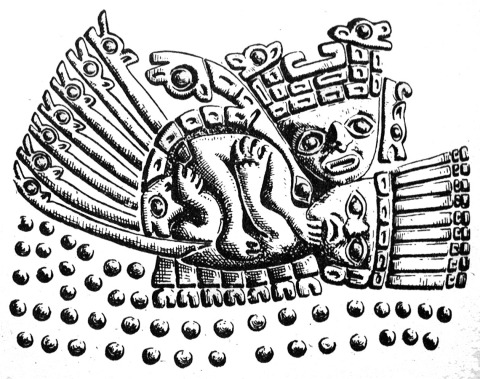
Depictions of the dead, with sexual organs and themes, are fairly common in Mochica art.
In one fascinating example of a stirrup vessel [fig. 6-6 in Benson 1972], there is a three dimensional rendering of an obviously dead couple on top of it. The man has one hand holding panpipes and the other around the woman in a tender embrace. There is a painted scene below them of skeletons in a field of wide spouted jugs with abundant stirrup vessels between them. A long flared ornamentation curving downward from the lower back side of each of the happy skeletons could easily be interpreted as defecation of a liquid. As ‘the ancestors’ (i.e. the dead that one is related to) figure widely in the hallucinogen using cultures, we cannot help but wonder if this use of these plants and the frequent depiction of the dead, was not done in their honor.
Considering that plants such as San Pedro were, and still are, used for such purposes as the healing of disease, blessing of crops and fishing expeditions, and effecting or combating ‘love magic”, and that similar scenes are repeatedly depicted on multiple vessels, perhaps their symbolism is related to what the intended purpose of ingestion was. There is a lot to suggest that what was represented was related to what the intended use was to be.
Many authors have pointed out that numerous recognizable diseases are portrayed in a good number of these vessels and some are modeled after specific parts of the body such as feet. (Some claim this indicated a fascination and preoccupation with disease.) Certainly, having such clear depictions around while in a tripping state would enhance and solidify both intent and focus. [Symbolic focal points of intent still figure heavily into the use and power of the mesa.]
For some excellent examples of diseases being depicted in such ceramic art accompanied by photographs of people who are clearly afflicted by the same diseases; see Raoul D’Harcourt 1939. (He also includes a quite clear and unmistakable example of fellatio; the act of which can also be found depicted in multiple Google images of Moche artifacts.)
Obviously this is pure conjecture as we cannot know what went on in their minds. It is significant that many of these jugs existed in multiple instances and versions. Similar copies were easily made as the vessels were constructed from parts formed in molds. Clearly, many of their designs are not simply arbitrary decorations and need to be considered as significant. Certain themes are recurrent, duplicated on different vessels and persist through long periods of time spanning several cultures.
This persistence of reproduced images and the fact that such vessels were duplicated in molds suggests a thriving market in prepared drug solutions. If this was the case, such images could have served as a simple means of labeling & identifying the contents, or even intended applications, to an illiterate society.
On page 106, Dobkin de Rios 1984 mentions that copulation between animals is sometimes depicted and that around 20% of these examples involve toads. Curiously, in the depiction of the enema administration, mentioned above, what looks like an anthropomorphized toad stands nearby, facing the copulating couple. (Benson calls it a ‘lizard helper’, and in two of Donnan’s multiple representations it does look more lizard-like.)
[Benson 1972 shows an interesting example of what appears to be a jaguar, or else a toad with pronounced jaguar features, having sex with a toad. Another portrayal of a toad/jaguar relationship has been unearthed during the excavations at Cacaxtla in central Mexico. A toad, wearing a jaguar skin, grasping what is said to be a ‘venus symbol’, is depicted in one of the murals at the Red Temple’s entrance. See Stuart 1992, p. 136, for a color photo.]
On page 84 of Dobkin de Rios 1982 there is a picture of a stirrup vessel showing a man and a woman clearly engaged in anal intercourse near what looks curiously like Anadenanthera seed pods. She points out (1982 & 1990) that wilka (vilca) was a major drug plant of the Ayacucho highlands region to the east of the Nazca culture and easily accessible as numerous economic plants were traded. It also might be noteworthy that large stands of Anadenanthera peregrina still exist in northern Peru and southern Ecuador and some also contain abundant populations of Trichocereus pachanoi.
Heterosexual sodomy is far more frequently encountered than actual sexual intercourse on the ceramic art that has been found to date.
Due to many European cultures’ general revulsion for even considering such acts openly, when heterosexual sodomy was encountered as a prevalent sexual act by the 17th century Spanish invaders, their horrified priests were instructed by Rome to extirpate such “ungodly” practices.
It should be added that the sexual themed Peruvian ceramics have always been very popular and highly sought after by some groups of art collectors and hence much grave robbing/looting, thefts at all levels, black-market sales and private pieces hidden from view or public knowledge has accompanied their removal from the earth and hampered any true assessment of what actually exists.
It has been proposed that sodomy and fellatio were practiced as forms of population control within a flourishing society living within very real environmental limitations.
Administration of substances by enema was not limited to Peru. In Safford’s 1916 work on parica snuff (usually derived from Anadenanthera spp. seeds) he mentions the use of rubber syringes, described by De la Condamine in 1749, as being used by the Omagua to administer similar ritual substances preceding “the repasts of ceremony” and mentions other travelers reported that extracts thought to be from the same seeds were also administered as enemas by other people. (Such as Spix & Martius 1831 mentioned earlier.) This route was said to be less powerful than when used as a snuff.
The extremely dangerous (and easily fatal) use of a tobacco enema has also been recorded.
San Pedro or peyote are readily utilizable when taken as a retention enema. It has been reported that salt forms are more readily absorbed than crude plant extracts. Case et al. 2004.
Note 35: The upper LH corner image in fig. 39, marker #1625.
Note 36: Another point of possible importance is that, while mescaline has not been reported from Tephrocacti yet, nor for that matter from most Opuntias which have been analyzed, the small jointed species of Opuntias (called Tephrocacti for the South American species) have generally shown the highest levels of alkaloid content observed among the Opuntias.
Note 37: Lyman Benson mentions that this claim is in dispute but included no details.
Note 38: This is often given as Opuntia basilaria. I have not seen Engelmann & Bigelow. I used the spelling as given by Lyman Benson 1982.
Note 39: Some may be light brown or tan on some joints.
Note 40: “Provoca sueños profundos”
Note 41: Oddly, when Clement et al. 1998 identified mescaline in “leaves, petioles and tender stems” of Acacia rigidula, it was said to be accompanied by N-methyl and N,N-dimethyl-mescaline, amphetamine, methamphetamine & N,N-dimethlyamphetamine, additionally many other N-methylated phenethylamines & tryptamines (including DMT) and also β-Methoxy-3,4-dihydroxy-5-methoxyphenthylamine but strangely NOT β-Hydroxymescaline.
It was additionally said to contain a number of never-before-seen-in-nature alkaloids including a total of 6 different amphetamines & 3,4,5-Trihydroxyphenethylamine.
Perhaps most noteworthy is the significant fact that no one has been able to replicate their claims.
Note 42: Thomas MacDougall & Faustino Miranda’s generic assignment was also given as a provisional name.
See Miranda 1954: pp. 139-140
Also encountered as Escontria gaumeri but I can locate no describer or description under this binomial.
Note 43: tlc, was still in its infancy and was not yet considered a standard analytical tool.
gc-ms, as we know it today, did not yet exist.

